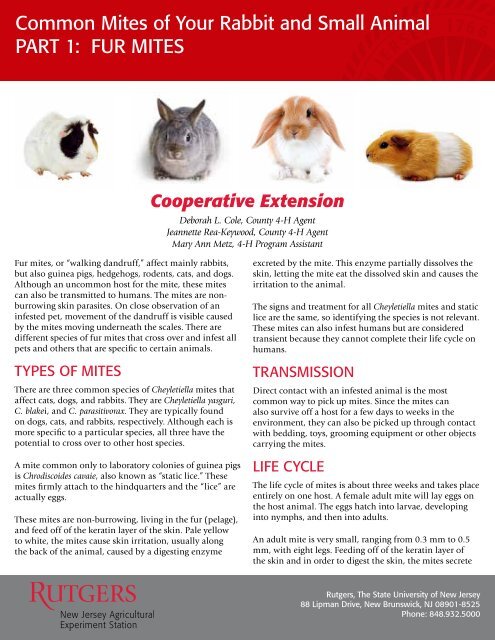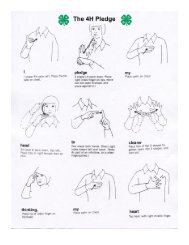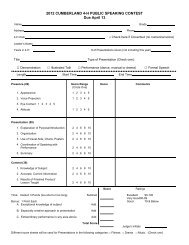Common Mites of Your Rabbit and Small Animal - cumberland ...
Common Mites of Your Rabbit and Small Animal - cumberland ...
Common Mites of Your Rabbit and Small Animal - cumberland ...
Create successful ePaper yourself
Turn your PDF publications into a flip-book with our unique Google optimized e-Paper software.
<strong>Common</strong> <strong>Mites</strong> <strong>of</strong> <strong>Your</strong> <strong>Rabbit</strong> <strong>and</strong> <strong>Small</strong> <strong>Animal</strong><br />
PART 1: FUR MITES<br />
Fur mites, or “walking d<strong>and</strong>ruff,” affect mainly rabbits,<br />
but also guinea pigs, hedgehogs, rodents, cats, <strong>and</strong> dogs.<br />
Although an uncommon host for the mite, these mites<br />
can also be transmitted to humans. The mites are nonburrowing<br />
skin parasites. On close observation <strong>of</strong> an<br />
infested pet, movement <strong>of</strong> the d<strong>and</strong>ruff is visible caused<br />
by the mites moving underneath the scales. There are<br />
different species <strong>of</strong> fur mites that cross over <strong>and</strong> infest all<br />
pets <strong>and</strong> others that are specific to certain animals.<br />
TYPES OF MITES<br />
There are three common species <strong>of</strong> Cheyletiella mites that<br />
affect cats, dogs, <strong>and</strong> rabbits. They are Cheyletiella yasguri,<br />
C. blakei, <strong>and</strong> C. parasitivorax. They are typically found<br />
on dogs, cats, <strong>and</strong> rabbits, respectively. Although each is<br />
more specific to a particular species, all three have the<br />
potential to cross over to other host species.<br />
A mite common only to laboratory colonies <strong>of</strong> guinea pigs<br />
is Chrodiscoides cavaie, also known as “static lice.” These<br />
mites firmly attach to the hindquarters <strong>and</strong> the “lice” are<br />
actually eggs.<br />
These mites are non-burrowing, living in the fur (pelage),<br />
<strong>and</strong> feed <strong>of</strong>f <strong>of</strong> the keratin layer <strong>of</strong> the skin. Pale yellow<br />
to white, the mites cause skin irritation, usually along<br />
the back <strong>of</strong> the animal, caused by a digesting enzyme<br />
Cooperative Extension<br />
Deborah L. Cole, County 4-H Agent<br />
Jeannette Rea-Keywood, County 4-H Agent<br />
Mary Ann Metz, 4-H Program Assistant<br />
excreted by the mite. This enzyme partially dissolves the<br />
skin, letting the mite eat the dissolved skin <strong>and</strong> causes the<br />
irritation to the animal.<br />
The signs <strong>and</strong> treatment for all Cheyletiella mites <strong>and</strong> static<br />
lice are the same, so identifying the species is not relevant.<br />
These mites can also infest humans but are considered<br />
transient because they cannot complete their life cycle on<br />
humans.<br />
TRANSMISSION<br />
Direct contact with an infested animal is the most<br />
common way to pick up mites. Since the mites can<br />
also survive <strong>of</strong>f a host for a few days to weeks in the<br />
environment, they can also be picked up through contact<br />
with bedding, toys, grooming equipment or other objects<br />
carrying the mites.<br />
LIFE CYCLE<br />
The life cycle <strong>of</strong> mites is about three weeks <strong>and</strong> takes place<br />
entirely on one host. A female adult mite will lay eggs on<br />
the host animal. The eggs hatch into larvae, developing<br />
into nymphs, <strong>and</strong> then into adults.<br />
An adult mite is very small, ranging from 0.3 mm to 0.5<br />
mm, with eight legs. Feeding <strong>of</strong>f <strong>of</strong> the keratin layer <strong>of</strong><br />
the skin <strong>and</strong> in order to digest the skin, the mites secrete<br />
Rutgers, The State University <strong>of</strong> New Jersey<br />
88 Lipman Drive, New Brunswick, NJ 08901-8525<br />
Phone: 848.932.5000
an enzyme that actually dissolves a small part <strong>of</strong> the<br />
skin. This is what causes the itchy, hair loss, scabs, <strong>and</strong><br />
discomfort.<br />
SIGNS AND SYMPTOMS<br />
Visual signs include chronic d<strong>and</strong>ruff, “walking<br />
d<strong>and</strong>ruff,” chronic scratching <strong>of</strong> the hindquarters, nape <strong>of</strong><br />
neck, <strong>and</strong> along the back, sores or scabs in the same areas,<br />
<strong>and</strong> hair loss. Microscopic diagnosis <strong>of</strong> the mites or eggs<br />
recovered by a skin scraping, combing, or acetate tape can<br />
positively identify an infestation. Affected skin may be<br />
slightly reddened, oily, hairless, <strong>and</strong> have scaly patches on<br />
the head, shoulders, <strong>and</strong> back. In rabbits, C. parasitivorax<br />
might not cause signs or it can result in loose hair pulled<br />
out in clumps. Hedgehogs have been known to lose quills<br />
C. cavaie may cause little signs or cause scratching,<br />
redness, hair loss, <strong>and</strong> flaking in guinea pigs. A rough<br />
hair coat <strong>and</strong> even skin ulcers can result from continuous<br />
grooming.<br />
TREATMENT<br />
<strong>Mites</strong> are transmitted by direct contact with the host,<br />
animal bedding, or hair <strong>and</strong> debris. Therefore, it is<br />
important to clean <strong>and</strong> treat the environment while<br />
treating the animal. Treat any animals in contact with the<br />
infested animal even if they are not showing any signs.<br />
Thoroughly clean <strong>and</strong> treat the areas where your pet<br />
sleeps <strong>and</strong> roams. This includes bedding, carpets, s<strong>of</strong>as,<br />
chairs <strong>and</strong> cushions, <strong>and</strong> stuffed toys. Make sure to<br />
vacuum carpets <strong>and</strong> cushions before treating to increase<br />
penetration <strong>of</strong> the dust or powder. Steam cleaning <strong>and</strong><br />
shampooing is not recommended as this could create the<br />
type <strong>of</strong> conditions they prefer. Prior to any application, read<br />
<strong>and</strong> follow all directions making sure the product is safe for<br />
rabbits, cavies, or other small animals.<br />
<strong>Common</strong> recommended pesticides include lime sulfur<br />
dips, ivermectin or selamectin, permethrins, pyrethroids,<br />
<strong>and</strong> phenylpyrazoles . Phenylpyrazoles <strong>and</strong> permethrins<br />
should not be used for rabbits or cavies. Always consult<br />
with your veterinarian before beginning any treatment.<br />
Apply dusts <strong>and</strong> liquid topical treatments near the<br />
shoulder blades, back <strong>of</strong> neck, <strong>and</strong> on the rump. Prior<br />
to any application, read <strong>and</strong> follow all directions making sure<br />
the product is safe for rabbits, cavies, or other small animals.<br />
In unresponsive cases, injections <strong>of</strong> ivermectin are <strong>of</strong>ten<br />
used. In all cases, treatment will need to be repeated<br />
two to three times varying from five days to three weeks<br />
depending on the pesticides used. The adult mites are<br />
killed during the first treatment, but eggs that remain in<br />
the fur or the environment will hatch <strong>and</strong> the larvae will<br />
grow <strong>and</strong> lead to a new infection cycle. The follow up<br />
treatments will kill the later ones.<br />
The best practice is prevention <strong>of</strong> an infestation through<br />
consistently clean bedding, pens <strong>and</strong> cages, h<strong>and</strong>washing,<br />
<strong>and</strong> not sharing grooming equipment, toys, or<br />
bedding, regular grooming, <strong>and</strong> frequent health checks.<br />
References<br />
Jeromin, Alice. (2008, May). Cheyletiella mites:<br />
Population on the move. DVM In Focus, 20-24.<br />
Krempels, D., Ph. D. (2008). Fur loss <strong>and</strong> skin problems<br />
in rabbits: <strong>Common</strong> causes <strong>and</strong> treatments [on-line].<br />
Available: http://www.bio.miami.edu/hare/furloss.<br />
html#furmite<br />
Percy, D.E. <strong>and</strong> Barthold, S.W. (2001). Pathology <strong>of</strong><br />
Laboratory Rodents <strong>and</strong> <strong>Rabbit</strong>s (2nd edition). Ames,<br />
Iowa: Iowa State University Press.<br />
Van Pragg, E., Maurer, A., <strong>and</strong> Saarony, T. (2010). Skin<br />
Diseases <strong>of</strong> <strong>Rabbit</strong>s (First edition). Medi<strong>Rabbit</strong>.com<br />
White, SD; Bourdeau, PJ; Meredith, A. (2003).<br />
Dermatologic problems in guinea pigs. Compendium on<br />
Continuing Education for the Practicing Veterinarian, 25<br />
(9), 690-697.<br />
© 2012 Rutgers, The State University <strong>of</strong> New Jersey. All rights reserved.<br />
For a comprehensive list <strong>of</strong> our publications visit www.njaes.rutgers.edu February 2012<br />
Cooperating Agencies: Rutgers, The State University <strong>of</strong> New Jersey, U.S. Department <strong>of</strong> Agriculture, <strong>and</strong> County Boards <strong>of</strong> Chosen Freeholders. Rutgers Cooperative Extension, a unit <strong>of</strong> the<br />
Rutgers New Jersey Agricultural Experiment Station, is an equal opportunity program provider <strong>and</strong> employer.<br />
Rutgers, The State University <strong>of</strong> New Jersey<br />
88 Lipman Drive, New Brunswick, NJ 08901-8525<br />
Phone: 848.932.5000
<strong>Common</strong> <strong>Mites</strong> <strong>of</strong> <strong>Your</strong> <strong>Rabbit</strong> <strong>and</strong> <strong>Small</strong> <strong>Animal</strong><br />
PART 2: CAVY LICE<br />
Cavy lice, sometimes referred to as running lice, are host<br />
specific <strong>and</strong> need a guinea pig to survive. These lice are<br />
considered chewing lice, not sucking lice, <strong>and</strong> actually<br />
abrade the skin to obtain fluid.<br />
TYPES<br />
The most common type <strong>of</strong> louse is Gliricola porcelli. This<br />
is a slender, flattened, light colored (white to pale) insect<br />
about 1 to 1.5 mm in size with no wings. The lice wriggle<br />
<strong>and</strong> can be seen moving through the fur near the skin<br />
<strong>and</strong>, in heavy infestations, around the eyes. Gyropus ovalis<br />
is less common <strong>and</strong> oval in shape, but is also flattened,<br />
with no wings, <strong>and</strong> from 1 to 1.2 mm in size.<br />
A third, <strong>and</strong> very rare species <strong>of</strong> louse, is Trimenopon<br />
hispidium. Light infestations are very easily missed while<br />
heavy infestations cause hair loss (alopecia), heavy<br />
scratching, <strong>and</strong> a rough coat.<br />
TRANSMISSION<br />
Lice seldom leave a host <strong>and</strong> transmission normally<br />
happens through direct contact with another guinea pig<br />
or contaminated bedding or other equipment. A person<br />
carrying an infested animal can also transfer eggs or lice<br />
from their clothing to another animal.<br />
Cooperative Extension<br />
Deborah L. Cole, County 4-H Agent<br />
Jeannette Rea-Keywood, County 4-H Agent<br />
Mary Ann Metz, 4-H Program Assistant<br />
LIFE CYCLE<br />
The life cycle <strong>of</strong> lice is about three weeks. Eggs are<br />
attached to the hairs <strong>of</strong> the host <strong>and</strong> a nymph will hatch<br />
three to 14 days later. Next it will go through three<br />
nymph stages, each about one week, <strong>and</strong> then molt into<br />
an adult <strong>and</strong> begin to mate continuing the cycle. Lice<br />
have no free living stages <strong>and</strong> will die quickly in the<br />
absence <strong>of</strong> a host.<br />
SYMPTOMS<br />
Lice are typically found around the head, neck, ears, <strong>and</strong><br />
rump. Some infestations go unnoticed until the animal<br />
begins to exhibit physical signs that include:<br />
-Excessive scratching<br />
-Hair loss<br />
-Sores <strong>and</strong> scabs<br />
-Scaly, dry, <strong>and</strong> thickened skin<br />
Lice are not normally life threatening, but young,<br />
elderly, <strong>and</strong> weakened animals will suffer more. A heavy<br />
infestation may be a symptom <strong>of</strong> some other underlying<br />
condition, including malnutrition, chronic disease, or<br />
immune deficiency, since debilitated animals <strong>of</strong>ten do not<br />
groom themselves, leaving the lice undisturbed.<br />
Rutgers, The State University <strong>of</strong> New Jersey<br />
88 Lipman Drive, New Brunswick, NJ 08901-8525<br />
Phone: 848.932.5000
TREATMENT<br />
While G. porcelli <strong>and</strong> G. ovalis are specific only to guinea<br />
pigs, they are highly contagious between guinea pigs. It’s<br />
important when introducing new pigs into an existing<br />
group that they are quarantined <strong>and</strong> examined for lice.<br />
Topical treatments <strong>of</strong> ivermectin or imidacloprid can<br />
easily kill lice, since they are biting not sucking pests.<br />
Treatment with imidaclopid is by weight, usually at 10<br />
mg per pound or 0.1 cc per pound. An application will<br />
usually last for up to 30 days. Since ivermectin is a strong<br />
drug <strong>and</strong> absorbed through the skin, an accurate dose is<br />
required to avoid side effect – including death.<br />
Insecticides in the class <strong>of</strong> benzoylphenylureas, such as<br />
diflubenzuron <strong>and</strong> triflumuron, have also been found to<br />
be effective in controlling chewing lice. Always carefully<br />
read labels to make sure it is appropriate for your animal <strong>and</strong><br />
for proper dosage. It is always recommended to consult your<br />
veterinarian.<br />
REFERENCES<br />
Reeves, W. <strong>and</strong> Miller, M. Spot-on treatments <strong>of</strong><br />
diflubenzuron <strong>and</strong> permethrin to control a guinea pig<br />
louse. Journal <strong>of</strong> Entomological Science, 44, 410-411.<br />
Scott, D., Miller, W., <strong>and</strong> Saunders, W.B. (2001).<br />
Dermatoses <strong>of</strong> pet rodents, rabbits <strong>and</strong> ferrets. Muller<br />
& Kirk’s <strong>Small</strong> <strong>Animal</strong> Dermatology, (6 th ed., pp. 1415-<br />
1453). Philadelphia, Pennsylvania: C E. WB Saunders<br />
Company.<br />
SPECIALIST REVIEW<br />
Changlu Wang, Extension Specialist in Urban<br />
Entomology, Department <strong>of</strong> Entomology, School <strong>of</strong><br />
Biological <strong>and</strong> Environmental Studies, Rutgers, The State<br />
University<br />
© 2012 Rutgers, The State University <strong>of</strong> New Jersey. All rights reserved.<br />
For a comprehensive list <strong>of</strong> our publications visit www.njaes.rutgers.edu February 2012<br />
Cooperating Agencies: Rutgers, The State University <strong>of</strong> New Jersey, U.S. Department <strong>of</strong> Agriculture, <strong>and</strong> County Boards <strong>of</strong> Chosen Freeholders. Rutgers Cooperative Extension, a unit <strong>of</strong> the<br />
Rutgers New Jersey Agricultural Experiment Station, is an equal opportunity program provider <strong>and</strong> employer.<br />
Rutgers, The State University <strong>of</strong> New Jersey<br />
88 Lipman Drive, New Brunswick, NJ 08901-8525<br />
Phone: 848.932.5000
<strong>Common</strong> <strong>Mites</strong> <strong>of</strong> <strong>Your</strong> <strong>Rabbit</strong> <strong>and</strong> <strong>Small</strong> <strong>Animal</strong><br />
PART 3: EAR MITES AND CANKER<br />
<strong>Rabbit</strong> ear mites, or Psoroptes cuniculi, are a common<br />
parasitic problem responsible for the condition known as<br />
ear canker. Considered one <strong>of</strong> the most common mites<br />
<strong>of</strong> rabbits, it also causes infection in cavies, horses, goats,<br />
antelopes, sheep, <strong>and</strong> cattle. Left untreated, canker can<br />
lead to secondary bacterial infections <strong>of</strong> the skin or invade<br />
the middle <strong>and</strong> inner ear leading to neurological disorders<br />
<strong>and</strong> fatal meningitis.<br />
TYPE<br />
P. cuniculi is a large, non-burrowing mite, round to oval in<br />
shape, which can be seen by eye on an infected animal.<br />
Often, however, the mites invade the deeper regions <strong>of</strong> the<br />
external ear canal where they are not visible. The mite is<br />
clearly visible when on the external folds <strong>of</strong> the ear <strong>and</strong><br />
inside the ear pinnae (ear flap). <strong>Mites</strong> pierce the skin at<br />
the base <strong>of</strong> hairs <strong>and</strong> use bell shaped suckers to feed on<br />
the host’s lymphatic fluids. The mucus <strong>and</strong> fecal material<br />
from the mites cause an inflammatory reaction resulting<br />
in severe itching.<br />
LIFE CYCLE<br />
Depending on environmental conditions, the cycle <strong>of</strong><br />
P. cuniculi is about 21 days. <strong>Mites</strong> will lay eggs in the ear<br />
wax or dead skin <strong>of</strong> the host. The eggs hatch into larvae in<br />
about four days. At this stage, the larvae have six legs <strong>and</strong><br />
will remain in this stage for four days <strong>and</strong> then begin to<br />
Cooperative Extension<br />
Deborah L. Cole, County 4-H Agent<br />
Jeannette Rea-Keywood, County 4-H Agent<br />
Mary Ann Metz, 4-H Program Assistant<br />
molt. After another three to 10 days, they become eightlegged<br />
protonymphs. The protonymphs will then molt<br />
into adults, which can mate <strong>and</strong> lay eggs.<br />
The mites can survive <strong>of</strong>f the host for four to 21 days. The<br />
survival rate is greatest when temperatures are low <strong>and</strong><br />
humidity high (greater than 75%).<br />
TRANSMISSION<br />
<strong>Rabbit</strong> ear canker is extremely contagious <strong>and</strong> generally<br />
spread by direct contact from an infected to non-infected<br />
animal. <strong>Mites</strong> simply crawl from one to another. The<br />
mites can also be transmitted through contact with the<br />
environment when an animal scratches or shakes, causing<br />
flakes <strong>of</strong> the mite-infested canker containing live mites<br />
<strong>and</strong> eggs to fall. It is thought that a pre-existing moist<br />
dermatitis provides a suitable environment for the mites<br />
to infest.<br />
Transmission is more likely when large numbers <strong>of</strong><br />
rabbits, or other susceptible hosts, are housed close to one<br />
another such as overcrowded hutches, pet shops, shelters,<br />
rabbit breeding facilities, <strong>and</strong> wild rabbit warrens.<br />
SIGNS AND SYMPTOMS<br />
An initial infestation may be overlooked if it begins<br />
deeper in the ear canal. Owners may notice ear scratching<br />
<strong>and</strong> head shaking at this early stage. Other signs include<br />
Rutgers, The State University <strong>of</strong> New Jersey<br />
88 Lipman Drive, New Brunswick, NJ 08901-8525<br />
Phone: 848.932.5000
edness, heat, <strong>and</strong> swelling <strong>of</strong> the ear canal. As the mites<br />
multiply, the infestation exp<strong>and</strong>s to the outer ear flap<br />
<strong>and</strong>, at this point, is clearly visible. It is not unusual to<br />
have only one ear infested.<br />
The host animal will normally be very agitated at<br />
this stage, itching <strong>and</strong> scratching at its ears <strong>and</strong> head<br />
frequently. The self-trauma <strong>of</strong> itching <strong>and</strong> scratching<br />
damages the ear skin even more resulting in more<br />
inflammation, itching, <strong>and</strong> scratching. The inflammation<br />
also causes serum <strong>and</strong> white blood cells to ooze onto the<br />
skin surface trapping the mites, feces, <strong>and</strong> skin cells <strong>and</strong><br />
then drying out. This produces the crusting, scabbing,<br />
<strong>and</strong> thick scale or gray, flaky skin debris attached to the<br />
inside <strong>of</strong> the ear flap. Underneath the crust, the skin is<br />
moist, hairless, <strong>and</strong> raw.<br />
The crusting <strong>and</strong> scabbing can spread to the head<br />
<strong>and</strong> neck, as well as other parts <strong>of</strong> the body, through<br />
grooming or untreated infestations that multiply. Ear<br />
drooping can also be due to the weight <strong>of</strong> scabbing<br />
around the outside <strong>of</strong> the ear.<br />
If left untreated, ear canker can lead to secondary<br />
bacterial infections adding to the pain <strong>and</strong> discomfort. A<br />
foul smell to the ear is an indication <strong>of</strong> an infection. Head<br />
tilt <strong>and</strong> signs <strong>of</strong> being <strong>of</strong>f-balance are also indicators <strong>of</strong><br />
secondary infections <strong>and</strong> a potential chronic condition.<br />
TREATMENT<br />
It is important to treat the infected animal <strong>and</strong><br />
the environment at the same time to prevent recontamination.<br />
While treating the animal, it is<br />
recommended to also remove the infected animal from its<br />
living environment to give the mites <strong>and</strong> eggs a chance to<br />
die <strong>of</strong>f. A large sized box or crate with clean, disposable<br />
bedding makes good temporary housing.<br />
Two main treatment options are available for treating ear<br />
mites. Systemic treatments use oral, injectable, or dermal<br />
absorbed antiparasitic drugs. Topical treatments apply<br />
antiparasitic medications directly to the infected areas as<br />
drops, powders, or oils. Systemic treatments are usually<br />
preferred because they require fewer repeat dosages, ease<br />
<strong>of</strong> giving, <strong>and</strong> better results.<br />
P. cuniculi are effectively treated with avermectin drugs,<br />
including ivermectin <strong>and</strong> selamectin. Injections or<br />
oral doses <strong>of</strong> ivermectin repeated over 14 days are<br />
more effective than topical applications <strong>of</strong> the same.<br />
Moxidectin, also an avermectin, has also been shown to<br />
be effective against ear canker mites.<br />
Removing the crust <strong>and</strong> scabs can be extremely painful<br />
to the animal <strong>and</strong> there is debate as to whether or not this<br />
should be done. If treated correctly, the medications will<br />
allow for easy removal <strong>of</strong> the crust within a few days or<br />
it will begin to fall <strong>of</strong>f on its own within 10 to 14 days <strong>of</strong><br />
treatment.<br />
Because rabbit ear mites can live for up to three weeks <strong>of</strong>f<br />
a host animal, it is important to decontaminate hutches,<br />
cages, burrows, feeding sources, <strong>and</strong> other items in the<br />
infested animal’s environment.<br />
Physically remove all contaminated <strong>and</strong> potentially<br />
contaminated bedding. It is nearly impossible to<br />
chemically decontaminate the large surface area <strong>of</strong><br />
bedding whether paper, straw, hay, or wood chips. It is<br />
best to just remove it all <strong>and</strong> replace with fresh, clean<br />
bedding.<br />
Rest the animal’s environment. Leaving the environment<br />
free <strong>of</strong> all rabbits, or other animals, for 4-6 weeks will<br />
make sure that it becomes mite free. Treat the hutches,<br />
cages, <strong>and</strong> bedding with an insecticide that is appropriate<br />
<strong>and</strong> safe for the animal. Always read the label carefully<br />
before using any insecticide chemical on an animal or its<br />
environment. Some insecticides are toxic to rabbits <strong>and</strong> cavies.<br />
Replace or move housing. Some hutches, especially those<br />
made <strong>of</strong> porous wood, are difficult to clean <strong>and</strong> remove<br />
mites once established. In these cases, it might be easier<br />
to replace a hutch or cage. If the animal’s housing is<br />
close <strong>and</strong> accessible to wild animal populations, consider<br />
moving or modifying to prevent wild mite-carriers from<br />
coming into contact with your animals.<br />
REFERENCES<br />
Scott, D., Miller, W., <strong>and</strong> Saunders, W.B. (2001).<br />
Dermatoses <strong>of</strong> pet rodents, rabbits <strong>and</strong> ferrets. Muller<br />
& Kirk’s <strong>Small</strong> <strong>Animal</strong> Dermatology, (6 th ed., pp. 1415-<br />
1453). Philadelphia, Pennsylvania: C E. WB Saunders<br />
Company.<br />
Hansen, O., Gall, Y., Pfister, K., <strong>and</strong> Wiel<strong>and</strong>, B. (2005).<br />
Efficacy <strong>of</strong> a formulation containing imidacloprid<br />
<strong>and</strong> moxidectin against naturally acquired ear mite<br />
infestations (psoroptes cuniculi) in rabbits. International<br />
Journal <strong>of</strong> Applied Research in Veterinary Medicine, 3 (4),<br />
281-286.<br />
© 2012 Rutgers, The State University <strong>of</strong> New Jersey. All rights reserved.<br />
For a comprehensive list <strong>of</strong> our publications visit www.njaes.rutgers.edu February 2012<br />
Cooperating Agencies: Rutgers, The State University <strong>of</strong> New Jersey, U.S. Department <strong>of</strong> Agriculture, <strong>and</strong> County Boards <strong>of</strong> Chosen Freeholders. Rutgers Cooperative Extension, a unit <strong>of</strong> the<br />
Rutgers New Jersey Agricultural Experiment Station, is an equal opportunity program provider <strong>and</strong> employer.<br />
Rutgers, The State University <strong>of</strong> New Jersey<br />
88 Lipman Drive, New Brunswick, NJ 08901-8525<br />
Phone: 848.932.5000










